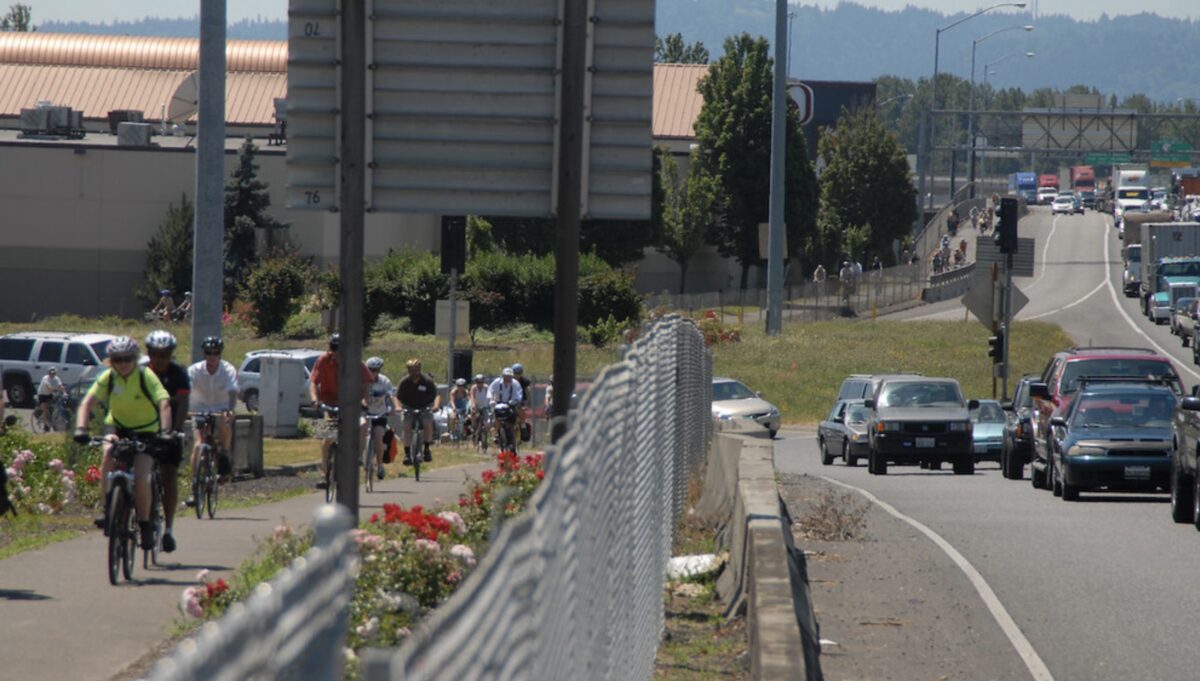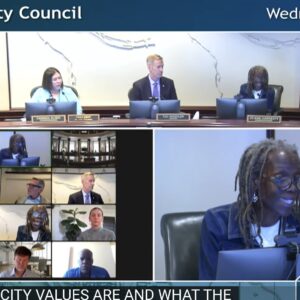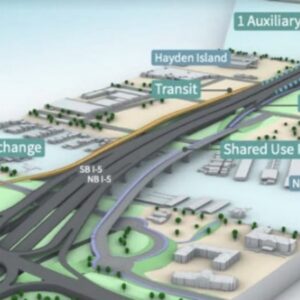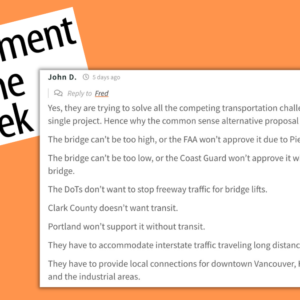“Activists hate it and business community hates it and therefore we absolutely must be moving in a direction that makes the most sense.”
– Jo Ann Hardesty, Portland City Commissioner
On Thursday, the Interstate Bridge Replacement project received the approval of state lawmakers and the heads of all of the regional authorities, giving it the green light to move forward into the environmental review process with their Locally Preferred Alternative (LPA) design.
A theme of compromise was threaded throughout many of the remarks made before the go-ahead was given.
“We must be on the right track, because activists hate it and business community hates it and therefore we absolutely must be moving in a direction that makes the most sense,” Portland’s Jo Ann Hardesty said in advance of her vote as part of the project’s Executive Steering Group. Metro President Lynn Peterson echoed her. “We can’t get hung up on the perfect. The perfect is not within reach because everybody’s is a different perfect,” she said, calling the LPA the “perfect Venn diagram” of where everybody could compromise.
Related: ODOT says US DOT Sec Pete Buttigieg will be Oregon’s ‘new best friend’
Many state lawmakers, particularly on the Oregon side, were also ready to embrace the idea of compromise at a meeting of the Joint Interim Committee on the Interstate 5 Bridge Thursday. “I have a significant number of people in my community, and in my district, who think that the auxiliary lane is too much,” Senator Lew Frederick said. “So, that’s the kind of balance, the kind of compromise that we’re looking at.”
But even as some electeds on the Washington side voiced concerns about the inclusion of light rail, the idea of tolling, and what they believe as a lack of new capacity in the draft design, Oregon State Senator Brian Boquist contended that it was his chamber that the IBR program should be focused on outreach to. “Most people I talk to [in my caucus] remain concerned of the fact that it doesn’t look like one auxiliary lane will work, and it doesn’t look like capacity going forward is going to work,” he said. Unlike the other groups, the legislative committee didn’t take a formal vote on moving ahead. Washington has already provided its requested $1 billion allocation, with Oregon expected to make a similar allocation in 2023 to keep the project on schedule.
Distinguishing herself from the rest of the group of legislators was Oregon House Rep Khanh Pham, who has become an outspoken skeptic of the direction the IBR is headed. In contrast with her colleagues, Pham was trying to look underneath the information being handed to the legislative committee, including asking questions about the recent letter from the U.S. Coast Guard stating that reducing the current 178 foot clearance provided by the current bridge isn’t acceptable.
“I just can’t support moving forward with the draft EIS without including at least one alternative that would address the Coast Guard’s requirements,” Pham said at the hearing. “Last time around [when the project was called the Columbia River Crossing] when we tried to get the Coast Guard to move it delayed us for a one year and we ultimately did have to change the design which cost us millions.”
Pham’s skepticism centered on finances.
“If we don’t get the finances right for this, it will have impacts on a whole list of other transportation projects in our state. And as a community organizer, who has worked with so many communities asking for safety, investments like crosswalks — you know, things that may seem mundane but have real impacts on our communities — and have always been told ‘there’s not enough money, sorry, we can’t do it, there’s no money for that.’ As a legislator now I’m seeing that there is money, but it’s allocated for different things.”
In response to Pham’s questioning about the Coast Guard, IBR Administrator Greg Johnson revealed that if the height of the proposed bridge is raised, that could lead to a “distasteful” decision to remove the interchanges at either Hayden Island or SR 14 on the Vancouver waterfront.
Raising the bridge even more could mean an even tougher incline for bicycle riders and other non-car users and bigger impacts on downtown Vancouver and Hayden Island, which are already set to see an incredibly impactful new highway wall constructed as part of the project.

The height of the bridge deck is just one issue that will be further worked through by the IBR team as the project goes through a Supplemental Environmental Impact Statement (SEIS) process over the next two years or so.
We’ll also see more details — including how the bike and pedestrian path will be designed and what the light rail element of the project will look like. And lobbying over the number of lanes and capacity concerns from all sides will not go away.
As this megaproject moves forward, whether or not the fact that no one appears to be completely happy with it will be good or bad for the project’s fortunes, remains to be seen.








Thanks for reading.
BikePortland has served this community with independent community journalism since 2005. We rely on subscriptions from readers like you to survive. Your financial support is vital in keeping this valuable resource alive and well.
Please subscribe today to strengthen and expand our work.
No one is happy because they are shoe-horning in 3 different projects:
1) Replacement of the existing bridges for earthquake safety.
2) Widening the bridge and widening the freeway for several miles north and south, and building new interchanges
3) Adding a new light rail line and better bike/walk access
But since ODOT and WADOT want a wider highway, they are sticking the important parts, the earthquake retrofit and the rail, bus and bike access, all into one huge structure. This makes access worse for transit, pedestrians and bikes by forcing them all onto a high, steep bridge, and will make the project more expensive and riskier, but ODOT thinks the real risk is that they won’t get the road widening that they really want.
Exactly correct. They could do 1 & 3 with absolutely no controversy and for a fraction of the cost.
If #1 was just crossing Johnson Creek, I doubt this project would see the light of day, so the fact that the old bridges are not very earthquake resistant is a relatively minor issue – they’ve been around for over 100 years and they’ve held up so far during several earthquakes and floods.
It’s really about the fact they are old – no one likes old things in the USA – and that by today’s standards they are a bit ugly and don’t have the capacity for 20 lanes.
The cost goes up, way up, because (in ranked order IMO):
“Last and certainly least, the bridge needs to survive an earthquake that likely will never occur in our lifetimes…“
I hope an earthquake doesn’t occur in our lifetimes, but I wouldn’t count on it. My family lived in Valdez, AK during the 1964 “Great Alaska” (Good Friday) earthquake. I shudder to think what an earthquake of that magnitude (9.2) would do to our region. I was only nine years old, but I still have terrifying memories of that day.
Fortunately, most of our commercial and residential buildings were one or two-story wooden structures. The few cinder block buildings we had largely collapsed. I don’t think we had any brick buildings. Many of the people in Valdez who died that day were on our docks, which were destroyed by a tsunami. At least people in Portland won’t have to worry about that…
If interested, you can see some of the ‘after’ views of the Valdez townsite in this small collection of photos I took when I was there last August during a family remembrance trip. I added personal commentary to many of the photos.
“No one is happy” is the refuge of scoundrels. It means you’re doing something fundamentally wrong.
It’s really the way decision-makers talk themselves into something that has huge problems.
It’s like the opposite of Pareto optimality – “How can we make everyone worse off?”
Either we care about climate, or we don’t. This project is clearly the latter.
The main ones who are happy are the contractors who will make billions, paid for by taxpayers outside the region, and those who profit off of climate extremes – air conditioner salespeople, hospitals, etc.
Lynn Peterson’s “where everybody could compromise” is a really telling frame of who “everybody” is in her mind.
It doesn’t include:
Her “everybody” is “everybody who might get me elected governor one day.”
Many people care about the climate crisis in an abstract way while being resistant to the societal transformations needed to address this crisis.
Vanishingly few people care about the mitigation pathways delineated in the UN IPCC climate consensus with any kind of consistency. (Many cherry pick mitigations based on their particular sociopolitical ideology and ignore or deride the rest.)
I’m genuinely curious. By the time it opens if everyone crossing the new bridge is driving an electric car how will the bridge be contributing to climate change?
The question of whether the bridge needs to be replaced at all is a good one. After all if everyone is going to be in a self driving vehicle is this really a priority.
Electric cars pollute a huge amount.
They are very intensive to build, and then hide their pollution from their electricity far away.
Oregon’s electric energy mix is 39% hydro, 26% coal, 22% fossil “natural” gas, with the remainder being cleaner/less-salmon killing.
So about half is still coming from fossil fuels – via the electric plug.
<a href=”https://www.oregon.gov/energy/energy-oregon/pages/electricity-mix-in-oregon.aspx”>source</a>
Unfortunately they have been labeled – by sellers and Depts of Energy – as “zero emissions.” Which is just wrong.
We are talking about conditions ten years out and beyond and mostly for Washington commuters.
At this point most electric cars are coal burners since the additional demand they place on the grid comes from burning more coal. You are right, there is no such thing as zero emissions. Even once the grid is fossil fuel free, the tires on electric vehicles will still be spewing carbon into
the air. But I think it’s important in evaluating the bridge to think about the long term. The real problem with the bridge proposal is not it’s capacity but it’s design as a freeway at all.
IMO we’re talking here about what percentage of gross world product in 2075 is going to be dedicated to carbon sequestration and other geoengineering. My preference is for that to be a small number so we can invest our future tax dollars in better futures rather than correcting the sins of the past.
Even if we could manage a 100% conversion to EVs by 2050 we don’t have the electric capacity to support car use at the current rates. Gotta bend the energy consumption curve downward.
I’m happy to say that no one I voted for in this most recent election voted to advance this project. Until more people can say that, projects like this will continue.
It will certainly be informing my votes in the next cycle, to be sure.
I wish all Oregonians and Washington State residents thought as you do on their voting, but we all know the incumbents will get reelected – they always do. Same as it always is, same as it always will be.
If you want to stop this madness or at least divert it to something more useful, you’ll need to try something other than the ballot box.
I posted that Hardesty deserves to be defeated over this and my comment was not published… BP is obviously on her campaign so good luck.. Joann could come out for banning bicycles and JM would still be on that bus….
I doubt you will find Hardesty’s opponent advocating any improvement to the project. Hardesty and Peterson’s job is to get a consensus for the best project possible.
We need to decide whether that is good enough. The question then becomes how can we stop it in a way that empowers them to make it better.
I think Lynn Peterson’s list of “everyone” includes people whose support is necessary for the project to move forward and people who have the ability to prevent it from moving forward if they are unhappy enough with the proposal. She may believe, or at least hope, that the activists who oppose the design don’t fit into that second category. She needs to be proven wrong. That is not an issue of intellectual discussion but power.
Since most Oregonians rarely use the bridge the folks with the largest stake in the outcome are in Washington. So if you are looking to have a popular uprising against the bridge, Washington is probably the place to start it. Unfortunately opposition to tolls and light rail are far more likely to kill the project than concern about a climate change inducing highway expansion.
Starting an uprising against the bridge among the people who most want the bridge makes no sense at all. We all know the bridge is really for people who moved to Clark County for the cheaper housing but continue to work in Portland. Commuters from WA should be paying for the lion’s share of the new bridge.
Commuters from Washington currently have a bridge they use for free. Wanting a new bridge and being willing to pay for the use are different. In fact, one purpose of the tolls is to reduce congestion by discouraging people from using the bridge because they are unwilling to pay the toll.
Then there are the anti-transit folks who don’t want to pay for light rail and folks who think investing in pedestrian and bike infrastructure is a waste of money. There are plenty of people on the Oregon side who support those things but are willing to sacrifice them to prevent a huge highway expansion. Why would it make “no sense at all” for people who support a highway expansion being willing to sacrifice it to prevent “wasting money” on bike, pedestrian and transit infrastructure?
That is especially true when the highway expansion isn’t sufficient to eliminate congestion without tolls to discourage people from using it. Tolling the existing bridge would work just as well. Remember the real question is whether there are enough people prepared to block the project, not that they all agree on the reasons for blocking it.
The State of Oregon should be required to divert some of the Oregon State Income tax they receive from Clark County residents working in Portland toward the project.
Firm disagree.
This is a good example of how the issue is not just about the city of Portland, but about the entire country. Too many people are involved in the process which will require several layers of government & bureaucracy. Let’s see how it goes but there should be a way to make these things much simpler.
“There should be a way to make these things much simpler.”
There is, its called authoritarianism. If we had a pure technocracy the highway engineers could just make the decision and the rest of us would just have to put up with the results.
No one likes diarrhea either. That doesn’t make it a good thing.
My take is that I5 through the heart of Portland is an anachronism. The real discussion should be about the transition away from it and the community goals for the recovered right of way. The Rose Quarter discussion would be a good starting point for that – without the highway expansion piece. And the I5 crossing would then need to support those same goals. That likely means local access as the centerpiece rather than interstate transportation.
Federal tax money, Biden giveaways, politicians that think it’s free money and know nothing about engineering but have to approve every detail
Why do the bike riders bus riders get a day, there level of use low, share of taxes they pay is low because they are poor.
It’s I5 let’s let the feds get this done. Leave everyone else out of it and get it done. Or give it to musk and get out of the way.
The bicycle crossing on the I 205 bridge is the worst bicycle bridge crossing I know of, with the noise, pollution, and bumpy ride with trash all over. I 5 isn’t much better, but it’s at least significantly shorter. Cyclists have been completely failed by both states, we have no voice and are simply an afterthought. It feels like we are grouped in with the homeless population.
I think the 205 bridge walkway and bike bath is awful because of being in the very middle. One man died in the winter storm of February, 2021 when he crashed an automobile on that bridge and went to the river side of it and went over the bridge and died. I wonder if regular walkways on the sides of that bridge would have changed that vehicle from going over it.
The current attitude “OK because both extremes hate it” reflects the superb sales job done by the IBR team. The engineering is clearly flawed. Marketing always trumps engineering. The question in my mind is, will logic prevail? I hope so.
Given the Coast Guard’s issues, was there ever discussin about building a tunnel instead of a bridge? If so, was that rejected out of hand or were there serious issues with a tunnel? I could see tunneling the automobile part and retrofitting one of the extisting bridges for bikes, peds and light rail.
A tunnel was considered 20+ years ago. There are serious issues with a tunnel. If I recall right, largely the issue was the lengthy approaches needed and conflicts with existing infrastructure.
I like the idea of the tunnel but from what I remember reading it would add an additional interchange on either side of the river without removing enough traffic replace the bridges.
At a minimum Mill Plain, Vancouver City Center, SR14, Hayden Island, and Marine Drive/Expo center are all too close to the river to access a tunnel.
A tunnel for max into Vancouver would be an interesting idea but funding for Max without a related freeway project would be difficult. CTRAN/Clark County has gone with a variation of BRT since there is so much opposition to light rail.
Of course the great irony here is that a massive new bridge (and adjacent freeway expansion) with tolls will probably be underutilized…as Joe Cortright points out.
Why not at least do an analysis of tolling the existing bridges? Tolls reduce demand…so they will have enough capacity, and the income can be used to seismically retrofit the old beauties on their great Doug Fir pilings.
20 years ago it was pointed out to the Governors’ I-5 Task Force that one third of the volume on the bridges was local traffic…looking for a Broadway Bridge type option to just get a few miles. Build that with MAX and a lovely bike/ped promenade!
But Ross Williams is right, the real challenge for this century is the removal of I-5 thought Portland, the dedication of all that land to close in housing and commerce.
It should never have been built.
How do you retrofit a pier in the river without narrowing the already undersized channel at the lift span?
The coast guard has said in the past that they don’t want to add additional bridge piers to the river between I5 and the railroad bridge. It complicates the currents and would make maneuvering between the bridges more difficult.
If you build it they will come… to new suburban developments in Clark County. Great for real estate developers, not good for the climate. We need increased urbanization to support rapid transit and human powered transit, not further car-centric infrastructure.